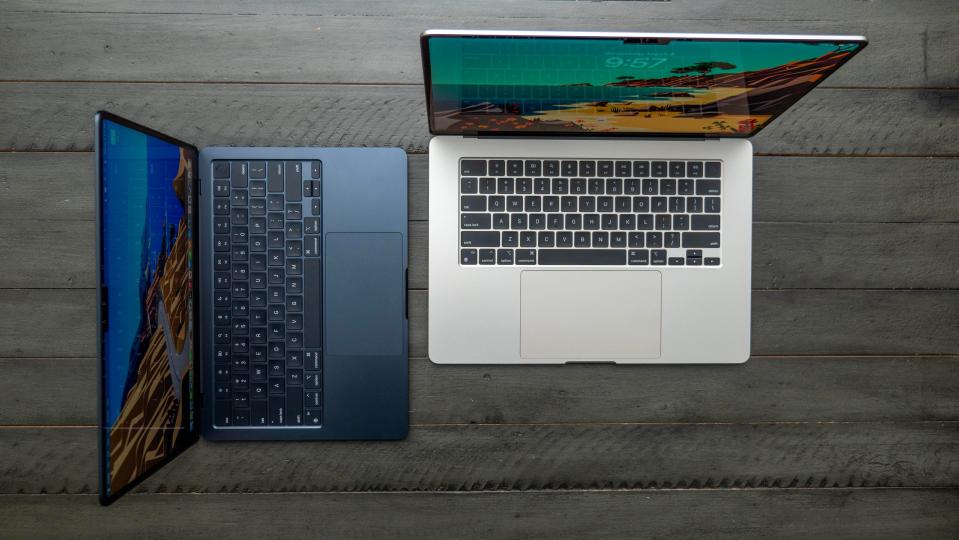If you are having trouble deciding between the cheaper and lighter MacBook Air or spending more for the more powerful MacBook Pro, then you’ve come to the right place. The MacBook Air and Pro don’t look all that different from one another, but there are key differences — from cost and components to performance and battery life — that you need to know to pick the right one. The M3 MacBook Air is the best laptop for most people, but there are some good reasons to spend more for a M4 MacBook Pro.
Let’s break down the MacBook Air against the MacBook Pro to see where and how these two laptop lines differ and which one is the best MacBook for you.
Newer Pro, older Air
No one wants to buy a laptop only to see it get updated a week or a month after you pull the trigger on a purchase. So, it’s important to know which MacBook is newer. The MacBook Pro gets the nod here. It was updated more recently, with Apple rolling out its latest M4 processors to the MacBook Pro near the end of last year. Meanwhile, it’s been nearly a year since Apple updated the MacBook Air; it received an M3 refresh last March.
Apple will almost assuredly update the MacBook Air soon. Rumors point to the Air getting an M4 update this spring and Apple introducing an M5 MacBook Pro in the fall.
Read more: Best MacBook for 2025
At this point, it’s worth waiting for the arrival of the M4 MacBook Air if you can (rumors have it arriving as soon as this month). If you are leaning toward the Pro, however, now is a good time to buy since we are closer to the introduction of the M4 Pro than we are to the anticipated release of an M5 Pro later this year.
Now that you know where each line stands in its refresh schedule, let’s take a look at the current pricing of the MacBook Air and MacBook Pro.

The current MacBook Air features Apple’s M3 processor and is available in 13-inch and 15-inch sizes.
MacBook Air vs. Pro: Cost and components
The MacBook Air is available with a 13.6-inch or a 15.3-inch display. The 13-inch Air starts at $1,099, and the 15-inch Air starts at $1,299. Both entry-level models feature Apple’s M3 processor along with 16GB of RAM and a 256GB SSD. There is a slight difference in GPU cores between these two starting models — the 13-inch Air’s M3 chip has eight CPU cores and eight GPU cores, and the 15-inch Air’s M3 chip has eight CPU cores and 10 GPU cores.
(Apple sells an M2 MacBook Air starting at $999, and Walmart has the M1 MacBook Air for $649, but I’m not going to include either of these budget models here. If you are waffling between the Air or Pro, then I’m going to assume that you have already decided to buy the M3 Air at a minimum and are wondering if you should step up to the M4 Pro.)
The MacBook Pro is available with a 14.2-inch or 16.2-inch display. The 14-inch Pro starts at $1,599, and the 16-inch Pro starts at $2,499. The 16-inch model has such a higher starting price because it has a more powerful M4 Pro chip, while the base model of the 14-inch Pro features an M4 (non-Pro) chip.
The M4 Pro chip in the 16-inch MacBook Pro is truly a pro-level processor, with 14 CPU cores and 20 GPU cores, while the M4 chip in the 14-inch model has 10 CPU cores and 10 GPU cores.
You can, however, get the M4 Pro chip in the 14-inch Pro. The step-up model in the 14-inch MacBook Pro series costs $1,999 and features an M4 Pro chip with 12 CPU cores and 16 GPU cores. The next model in the series costs $2,399 and features the same 14-CPU, 20-GPU M4 Pro found in the entry-level MacBook Pro 16.

The 14-inch MacBook Pro starts at $1,599 with an M4 processor and $1,999 with the upgraded M4 Pro chip.
Both the M3 and M4 chips feature a 16-core neural engine that supports Apple Intelligence features, but Apple claims that the M4 is twice as fast as the M3 with AI workloads.
For system memory, the baseline 14-inch MacBook Pro offers the same 16GB of RAM as you get with the MacBook Air, but the higher-end 14-inch models and every 16-inch model has a minimum of 24GB of RAM.
You also get more storage with the Pro models. The entry-level models for both the 13- and 15-inch MacBook Air offer only a 256GB solid-state drive (SSD). Even if you have embraced cloud storage, that’s an underwhelming amount of local storage. With any MacBook Pro, you start with at least a 512GB SSD. Doubling the meager storage to a 512GB SSD with a MacBook Air adds a hefty $200 to the bill.
MacBook Air vs. Pro: Weight and battery life
The Air wins on weight, but the Pro takes the battery life crown.
The 13.6-inch MacBook Air weighs 2.7 pounds, and the 15.3-inch Air weighs 3.3 pounds.
Despite giving up an inch in display size, the 14.2-inch MacBook Pro at 3.4 pounds weighs more than the larger Air. And it weighs appreciably more than the smaller Air, whose display is only 0.6 inches smaller.
I use a 14-inch Pro for work, and my daughter has a 13-inch Air for school. The difference in weight between the two is striking. I’m always jealous of the lighter carrying weight of the Air whenever I pack up my Pro for travel or just to take it down to my local coffee shop. The MacBook Air also takes up less space in a backpack. It’s just 0.44 inches thick, and the MacBook Pro is a chunkier 0.61 inches thick.
The added weight and thickness, however, allow Apple to pack a bigger battery inside the MacBook Pro. On CNET’s YouTube streaming battery drain test, the 14-inch MacBook Pro lasted one minute shy of 22 hours, which is among the best battery-life laptops.
The MacBook Air is also a long-running laptop, but its runtime is hours shorter than that of the MacBook Pro. In testing, the 13-inch Air lasted 18 hours and 17 minutes, and the 15-inch Air ran for an even 16 hours.
Given the long runtimes for both the MacBook Air and Pro (both offer all-day battery life) the difference in weight between the two is the larger factor if mobility is a chief concern. The MacBook Air is thinner and lighter — better for students crisscrossing campus every day and those who commute daily or travel regularly. Even the larger 15-inch Air is a better travel companion than the smaller 14-inch Pro.
MacBook Air vs. Pro: Display and speakers
MacBook Pro models have a slightly higher-resolution display and a higher pixels-per-inch count (224ppi on the Air to the Pro’s 254ppi), but the bigger differences between the displays are their brightness, HDR support and refresh rate.
The Macbook Pro’s Liquid Retina XDR display is a mini-LED panel rated for 1,000 nits in SDR and 1,600 nits in HDR. The MacBook Air’s Liquid Retina display is rated for 500 nits, which is bright enough for most lighting environments but lacks the range and contrast to make HDR content pop.
You’ll also get smoother movement in videos and games on the MacBook Pro’s 120Hz ProMotion panel. The MacBook Air offers a standard 60Hz refresh rate.
The MacBook Air and Pro each offer good audio output for a laptop, but the Pro’s sound is better. The MacBook Pro features a six-speaker array, and the Air has four speakers.

The MacBook Pro has more ports and speakers than the MacBook Air.
MacBook Air vs. Pro: Ports and fans
The MacBook Pro features more external connections. It has an HDMI port and SD card slot — neither of which you’ll find on the Air — along with an extra Thunderbolt port. The M4 Pro-based models also support Thunderbolt 5 for faster data and support for more external monitors than you get with Thunderbolt 4 on an Air.
The MacBook Air has the advantage in acoustics. It lacks a cooling fan and operates in complete silence.
MacBook Air vs. Pro: Performance
So, what do those extra CPU and GPU cores get you with the M4 MacBook Pro? We’ve tested both sizes of the M3 MacBook Air released last March and a pair of M4 MacBook Pro models from last November — the 14-inch Pro with the M4 chip and a loaded 16-inch Pro with an M4 Pro chip and a whopping 48GB of RAM.
On our Geekbench 6 test that measures overall CPU performance across a mixed workload, the 16-inch MacBook Pro put more distance between it and the 14-inch MacBook Pro than the smaller Pro could between it and the two MacBook Airs. And that makes sense when you consider the M4 Pro processor has four more cores than the M4 chip, which has only two more than the M3 chip in the MacBook Air models.
We saw similar results on the multicore CPU test for Cinebench 2024, and the even greater number of GPU cores of the M4 Pro allowed the 16-inch MacBook Pro to enjoy an even greater lead on the Cinebench 2024 GPU test over the 14-inch MacBook Pro.
Our benchmark results show that the baseline 14-inch MacBook Pro is somewhat in the awkward middle ground between a MacBook Pro with an M4 Pro chip and the M3 MacBook Air.
Should I buy a MacBook Air or MacBook Pro?
Creative pros and hobbyists who need to run demanding graphics applications would be better served by investing in a MacBook Pro with an M4 Pro processor. The superior CPU and GPU performance will allow such power users to complete creative workloads more quickly. The cheapest MacBook Pro with an M4 Pro processor costs $1,999, however, which is considerably more expensive than a MacBook Air.
The added memory you get with the MacBook Pro models that cost $1,999 and up helps justify the higher cost. You might not need the 48GB of RAM of the M4 Pro-based MacBook Pro we tested, but the 24GB of RAM you get with any M4 Pro-based MacBook Pro will certainly serve you well compared with the 16GB of RAM offered on the MacBook Air or baseline 14-inch M4 MacBook Pro.
The only compelling reason for the $1,599 M4-based MacBook Pro I can see is the HDR ProMotion display if you watch or work with a lot of HDR content. Or you are sensitive to video stutter on a 60Hz display. If neither of these characteristics describes you, then you are better off spending more for the greater performance of an M4 Pro-based MacBook Pro or saving some money and getting the more affordable and portable MacBook Air.
Read more: Best MacBook deals
For general home use, where you primarily use Chrome, Gmail, Google Docs and Sheets with perhaps the occasional project in iMovie or Garage Band, the M3 MacBook Air offers ample performance and is the better deal. The 13-inch MacBook Air provides a ton of value at $1,099 and can almost always be found discounted to less than $1,000. For most people, it’s the best laptop.
And if you want the larger screen size, you can opt for the 15-inch Air instead of needing to spend a premium on a MacBook Pro. Despite its larger display, the 15-inch Air is still thinner and lighter than the 14-inch Pro — while costing hundreds less.
#MacBook #Buy











Leave a Reply